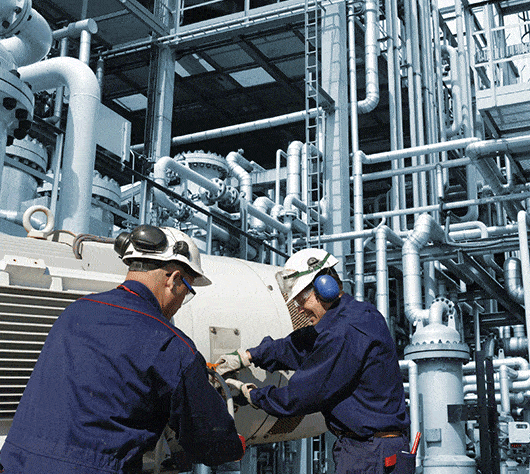Unknown Facts About Roar Solutions
Unknown Facts About Roar Solutions
Blog Article
Roar Solutions Can Be Fun For Everyone
Table of ContentsExcitement About Roar SolutionsRoar Solutions Fundamentals ExplainedSome Of Roar Solutions
In such an environment a fire or surge is feasible when three fundamental problems are met. This is typically described as the "hazardous location" or "burning" triangular. In order to shield setups from a prospective explosion an approach of evaluating and classifying a potentially hazardous location is needed. The function of this is to guarantee the proper choice and installation of devices to ultimately protect against an explosion and to make sure safety of life.
(https://allmyfaves.com/roarsolutions?tab=ROAR%20Solutions)
No tools needs to be installed where the surface area temperature of the devices is above the ignition temperature level of the provided hazard. Below are some usual dust hazardous and their minimal ignition temperature. Coal Dust 380C 225C Polythene 420C (thaws) Methyl Cellulose 420C 320C Starch 460C 435C Flour 490C 340C Sugar 490C 460C Grain Dust 510C 300C Phenolic Material 530C > 450C Aluminium 590C > 450C PVC 700C > 450C Residue 810C 570C The chance of the hazard being present in a focus high enough to trigger an ignition will certainly vary from location to place.
In order to identify this risk an installation is separated into locations of danger relying on the amount of time the harmful is present. These areas are described as Areas. For gases and vapours and dirts and fibres there are 3 zones. Zone 0 Area 20 A harmful atmosphere is very most likely to be present and might be present for extended periods of time (> 1000 hours each year) and even continually Zone 1 Zone 21 A hazardous ambience is feasible but not likely to be present for long durations of time (> 10 450 C [842 F] A classification of T6 implies the minimal ignition temperature is > 85 C [185 F] Unsafe area electric devices maybe created for usage in higher ambient temperatures. This would certainly suggested on the score plate e.g. EExe II C T3 Ta + 60C( This indicates at 60C ambient T3 will certainly not be gone beyond) T1 T1, T2, T3, T4, T5, T6 T2 T2, T3, T4, T5, T6 T3 T3, T4, T5, T6 T4 T4, T5, T6 T5 T5, T6 T6 T6 A T Class rating of T1 implies the optimum surface area temperature produced by the instrument at 40 C is 450 C. Assuming the linked T Course and Temperature rating for the equipment are appropriate for the area, you can always utilize a tool with an extra rigorous Division score than needed for the area. There isn't a clear response to this inquiry. It really does rely on the sort of devices and what fixings need to be accomplished. Equipment with details examination procedures that can't be carried out in the field in order to achieve/maintain 3rd party ranking. Must return to the manufacturing facility if it is prior to the devices's solution. Field Repair Work By Authorised Personnel: Complex screening might not be called for nevertheless certain treatments might require to be adhered to in order for the tools to preserve its 3rd party rating. Authorized employees have to be used to execute the job appropriately Repair service have to be a like for like substitute. New part have to be taken into consideration as a straight substitute calling for no unique testing of the equipment after the repair work is complete. Each piece of equipment with a dangerous ranking must be evaluated independently. These are laid out at a high degree below, however, for even more comprehensive details, please refer directly to the guidelines.
The Best Guide To Roar Solutions
The equipment register is a comprehensive data source of equipment documents that consists of a minimum set of areas to recognize each thing's place, technological specifications, Ex-spouse classification, age, and ecological data. The ratio of Thorough to Close assessments will certainly be identified by the Equipment Threat, which is examined based on ignition threat (the likelihood of a resource of ignition versus the likelihood of a combustible ambience )and the dangerous area category
( Zone 0, 1, or 2). Implementing a durable Risk-Based Assessment( RBI )strategy is click resources vital for making certain compliance and safety and security in handling Electric Equipment in Hazardous Areas( EEHA).
See This Report on Roar Solutions

In terms of explosive threat, a dangerous location is a setting in which an explosive atmosphere is existing (or may be anticipated to be present) in quantities that need special safety measures for the construction, setup and use devices. Roar Training Solutions. In this short article we explore the difficulties faced in the work environment, the threat control steps, and the called for expertises to function securely
These substances can, in specific problems, develop explosive environments and these can have significant and heartbreaking effects. Most of us are familiar with the fire triangle get rid of any one of the 3 elements and the fire can not occur, but what does this mean in the context of harmful locations?
In a lot of circumstances, we can do little about the degrees of oxygen in the air, yet we can have significant influence on resources of ignition, for instance electrical tools. Harmful areas are documented on the hazardous area classification drawing and are recognized on-site by the triangular "EX LOVER" indication. Below, amongst other key info, areas are split into three types depending upon the hazard, the chance and duration that an explosive environment will certainly exist; Area 0 or 20 is deemed the most harmful and Area 2 or 22 is deemed the least.
Report this page